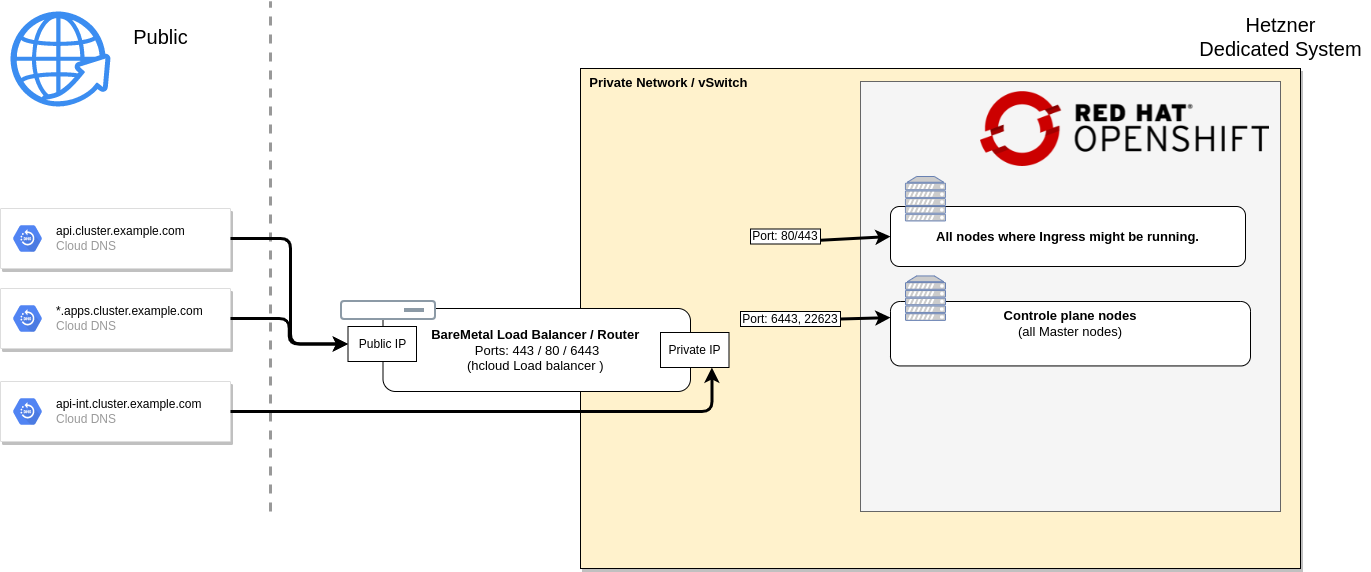Deppends on the cluster.
But for all: One of the worker is used to be the bootstrap during installation.
You can run all playbooks inside a toolbox :
toolbox create --image quay.io/operate-first/hetzner-baremetal-toolbox hetzner-toolbox
toolbox enter hetzner-toolboxSource of the toolbox Containerfile
cp -v hosts.yaml.example hosts.yaml
$EDITOR hosts.yaml-
Order a BareMetal Server as Load Balancer & Router.
- Prepare RHEL 8 Image
- Install Server with RHEL 8
-
Configure Network (public & private)
- Coonfigure server as router between priavet and public (act as default gateway for alle nodes.)
-
Configure load balancer:
- Public for api & ingress
- Private for api-int
-
Configure DNS entries for
api.<cluster_name>.emea.operate-first.cloudapi-int.<cluster_name>.emea.operate-first.cloud*.apps.<cluster_name>.emea.operate-first.cloud
-
Order a BareMetal Server - Issue for sizing: #6
-
Configure DNS ( A & PTR ) for BareMetal Server
<hostname>.emea.operate-first.cloud -
Create private vSwitch and add ID to
hosts.yaml -
Attach server to private vSwitch
-
Check network interface names on centos 8:
ansible -m shell -a "ip link | grep enp | cut -f2 -d':'" all -
Add server to
hosts.yaml -
Wipe all servers after Centos 8 installaion:
./wipe.yamlPlease run./wipe.yamlagain if some failed agure. -
Run a RH CoreOS Test installation with ssh-only ignition
./reset-server.yaml [-l hostname] # SSh into rescue system and run coreos-install # command printed out at the end ot the playbook.
Check installation, server boot? Can connect via SSH?
-
Boot Rescue mode
./force-rescue-mode.yaml [-l hostname]
Check if resecue system is booted:
If NOT: File a ticket to switch into EFI boot (Example Tickets: Ticket#2021050503020988, Ticket#2021050603003594, Ticket#2021051903013942)
-
Check if you can switch between RH CoreOS and rescue mode.
-
Configure firewall
./configure-hrobot-firewall.yaml [-l hostname]
Prerequisites:
- At least 4 prepared nodes (see Hardware preperations)
- DNS & load balancer preperations
Boots into rescue mode and prepare rescue system to install Red Hat CoreOS
./reset-server.yamlTo ensure nothing is on the disk wipe it:
./wipe-server.yaml./create-ignition.yaml./run-installer.yamlOptional split it into two steps:
./run-installer.yaml --skip-tags reboot
# Check output
./run-installer.yaml --tags rebootAccept pending CSR from your worker nodes
oc get csr | awk '/Pending/ { print $1}' | xargs -n1 oc adm certificate approvessh -l root -i <private-key> <private lb vm>
vi /etc/haproxy/haproxy.cfg
systemctl reload haproxyCheck a proxy stats
echo "show stat" | nc -U /var/lib/haproxy/stats | cut -d "," -f 1,2,18,57| column -s, -t;
# pxname svname status last_chk
machine-config-server FRONTEND OPEN
machine-config-server host01.example.com UP
machine-config-server host02.example.com UP
machine-config-server host04.example.com UP
machine-config-server BACKEND UP
api FRONTEND OPEN
api host01.example.com UP
api host02.example.com UP
api host04.example.com UP
api BACKEND UPMove bootstrap node from bootstrap to worker hostgroup.
./force-rescue-mode.yaml -l <bootstrap-node>./reset-server.yaml -l <bootstrap-node>./create-ignition.yaml -l <bootstrap-node>./wipe-server.yaml -l <bootstrap-node>./run-installer.yaml -l <bootstrap-node>Optional split it into two steps:
./run-installer.yaml --skip-tags reboot -l <bootstrap-node>
# Check output
./run-installer.yaml --tags reboot -l <bootstrap-node>Accept pending CSR from your worker node.
oc get csr | awk '/Pending/ { print $1}' | xargs -n1 oc adm certificate approveoc edit scheduler
Change mastersSchedulable: true to mastersSchedulable: false
Its recommended to wipe the disk with wipe-server.yaml playbook bevor reinstallation.
